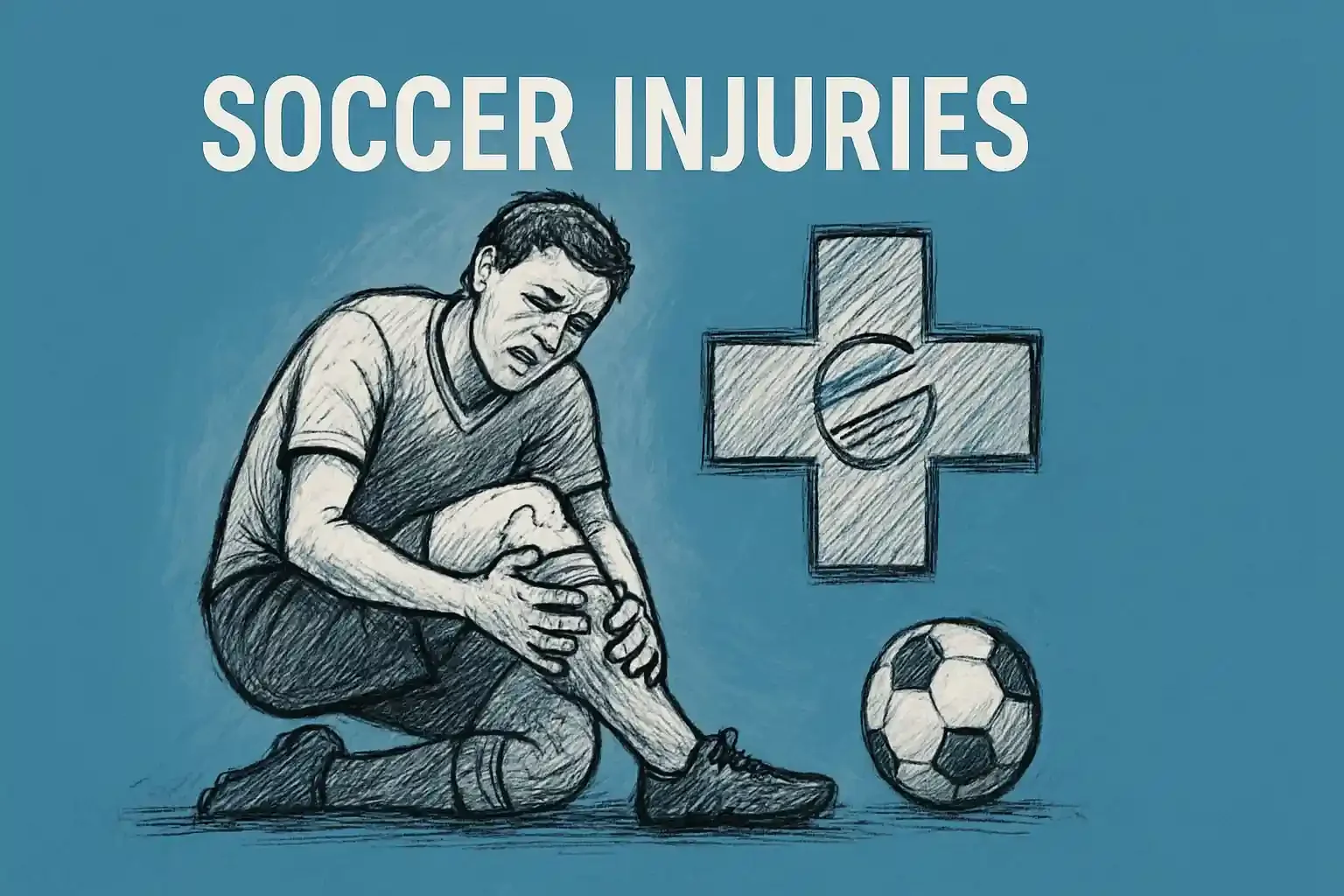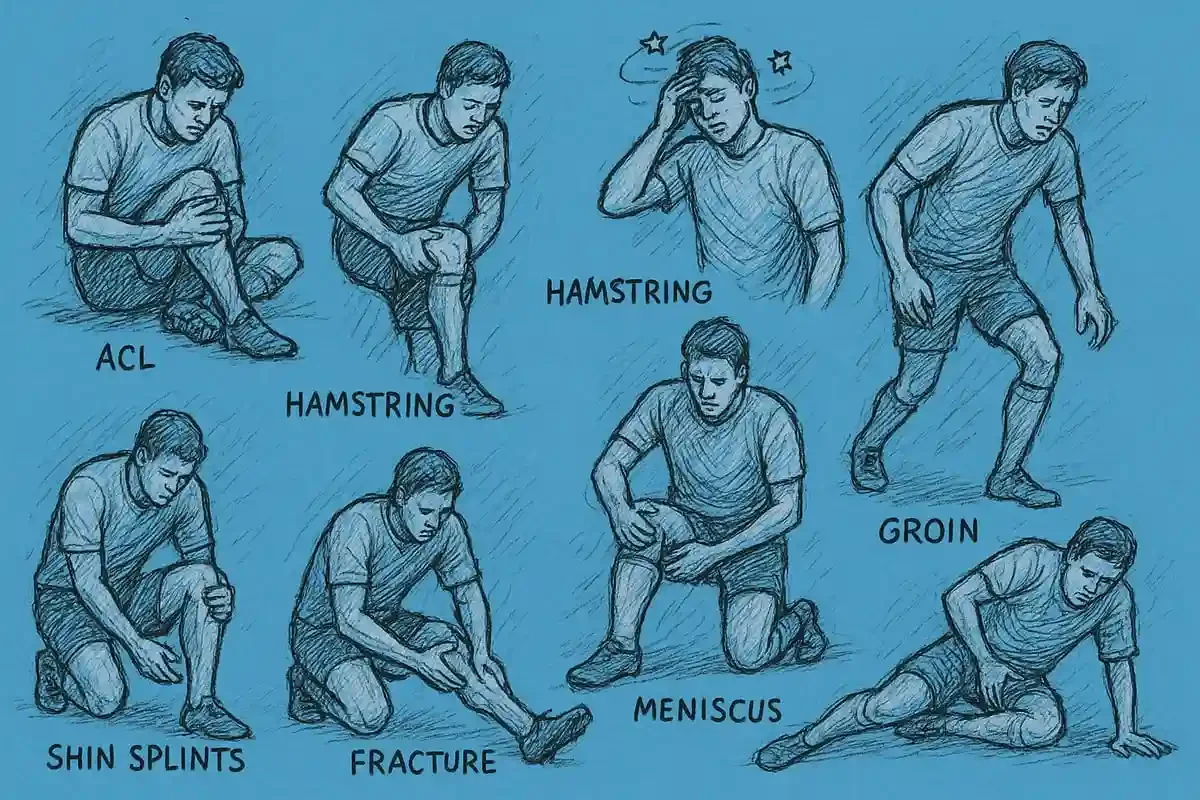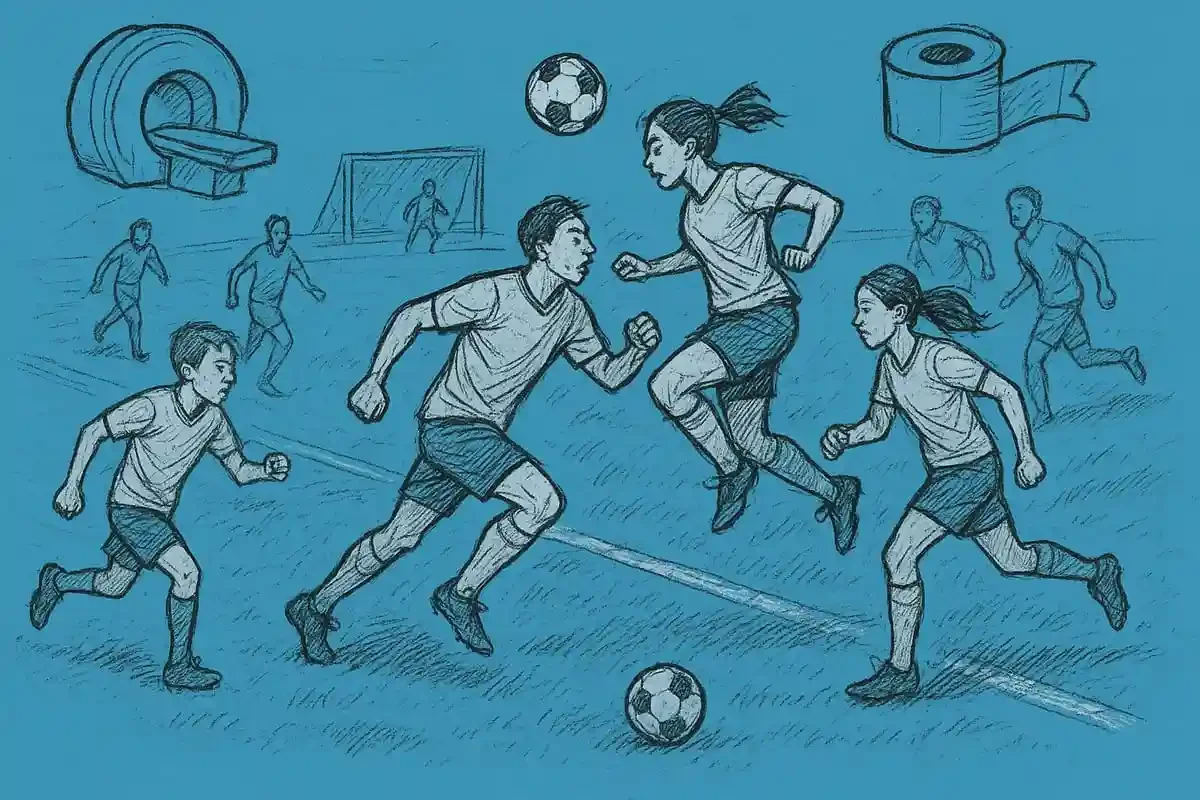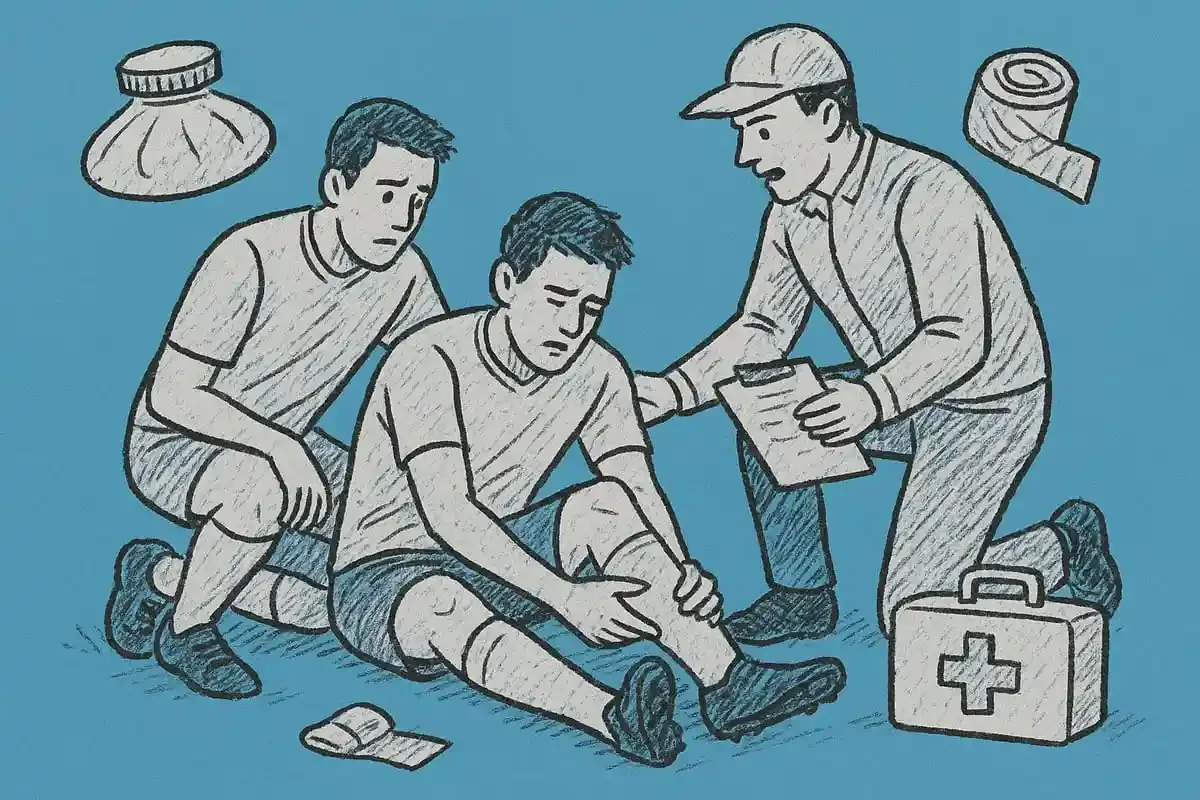8 of the Most Common Soccer Injuries in 2025
Did you know that soccer injuries are now one of the leading reasons players miss matches worldwide? The fast pace and high-contact nature of the game mean that even the fittest athletes are at risk.
This guide is here to help soccer players, parents, and coaches understand the most common injuries in 2025. By learning how to spot, prevent, and manage these issues, you can stay healthy and keep playing the sport you love.
Ready to discover the eight soccer injuries every player should know? Boost your awareness, speed up recovery, and stay ahead on the field by reading on.
Why Soccer Injuries Are on the Rise in 2025
Soccer has never been more popular, with millions of players of all ages joining leagues and tournaments worldwide. This explosive growth is exciting, but it also means that soccer injuries are becoming more common and severe than ever before. Understanding why these injuries are on the rise is essential for players, coaches, and parents who want to keep athletes safe and active on the field.
The Growing Popularity and Intensity of Soccer
Soccer's global appeal has never been higher, with participation rates soaring across youth, amateur, and professional levels. Players are training and competing more, often year-round, which puts constant stress on their bodies. Early specialization in soccer, where young athletes focus solely on the sport, leads to repetitive strain and higher risk for soccer injuries.
Advances in Sports Medicine and Injury Detection
New technologies in sports medicine, like MRI and ultrasound, make it easier to spot soccer injuries that once went undiagnosed. Improved reporting and tracking mean more injuries are counted and treated. Sports scientists now monitor players' health closely, picking up on problems early. This progress helps prevent long-term damage but also contributes to the rising numbers, as more soccer injuries are recognized and recorded.
Changing Play Styles and Training Demands
Modern soccer is faster and more physical than ever. Players sprint more, tackle harder, and jump higher, all of which increase the chance of soccer injuries. Tactical changes, like pressing and quick transitions, demand intense bursts of energy. The playing surface matters, too. A shift from natural grass to artificial turf alters how injuries happen, with some studies suggesting turf may raise the risk of certain soccer injuries.
Impact of Overuse and Inadequate Recovery
Overtraining is a major problem in today's soccer landscape. Many athletes practice and compete without taking enough rest days or mixing in other sports. This leads to overuse injuries, like stress fractures and shin splints, which are seen more frequently in clinics. Inadequate recovery means even minor soccer injuries can become chronic, affecting a player's long-term health and performance.
Gender and Age Differences in Soccer Injuries
Research shows soccer injuries do not affect everyone equally. Female players, for example, are more likely to suffer ACL tears due to anatomical and hormonal differences. Male athletes often experience more hip and groin strains. Age also matters: younger players face growth plate injuries, while older athletes are prone to meniscus tears and overuse problems. Recognizing these patterns helps tailor prevention strategies.
Importance of Awareness and Early Intervention
Knowing the signs of soccer injuries and taking quick action can make all the difference. Early intervention leads to faster recovery and reduces the risk of long-term issues. Real-life cases show that players who recognize symptoms and seek treatment return to play sooner and with fewer complications. Education and awareness are vital tools in the fight against rising soccer injuries.
8 Soccer Injuries Every Player Should Know in 2025
Soccer is a fast, physical game, and even the best preparation can't always prevent injuries. But knowing the most common soccer injuries, their warning signs, and how to handle them can make the difference between a quick recovery and a season on the sidelines. Below, we break down the eight soccer injuries every player should know in 2025, with practical tips to help you stay healthy and keep your game strong.
1. Anterior Cruciate Ligament (ACL) Tears
The ACL is a vital ligament in the knee, giving stability for sudden stops, pivots, and changes in direction. ACL tears are one of the most feared soccer injuries, often happening when a player lands awkwardly, twists, or rapidly decelerates.
Common symptoms include a loud pop at the moment of injury, immediate swelling, and a sense of the knee giving way. Many players, especially females, face a higher risk due to anatomical and hormonal differences.
In fact, recent studies show a surge in ACL injuries among professional soccer players, with these injuries accounting for a significant portion of surgeries in the sport. The recovery process typically involves rest, physical therapy, and often surgical reconstruction, followed by a lengthy rehab period.
Prevention focuses on neuromuscular training, strengthening the muscles around the knee, and learning proper landing techniques. Regularly practicing these routines can help players lower their risk of soccer injuries related to the ACL.
2. Hamstring Strains
Your hamstring muscles run along the back of your thigh and power explosive sprints, jumps, and kicks. Hamstring strains are among the most common soccer injuries, usually caused by sudden acceleration, overstretching, or fatigue.
Symptoms include sharp pain at the back of the thigh, bruising, and difficulty moving the leg. These injuries are notorious for recurring if not properly rehabilitated, which is why pro athletes often take their time returning to play.
Treatment starts with the POLICE protocol - protection, optimal loading, ice, compression, and elevation - followed by physiotherapy and a gradual return to activity. Prevention includes dynamic warm-ups, flexibility training, and eccentric strengthening exercises.
Remember, a well-conditioned hamstring is less likely to fall victim to soccer injuries, so include these preventative steps in every training session.
3. Concussions and Head Injuries
Concussions are brain injuries caused by bumps, blows, or jolts to the head, and they are a growing concern in soccer. Players can suffer concussions from heading the ball, collisions with other players, or falls.
Symptoms might show up immediately or develop over hours: headache, dizziness, confusion, nausea, and sensitivity to light or noise. Soccer injuries to the head are especially serious because they can have long-term effects on memory and concentration.
Protocols like SCAT6 and gradual return-to-play guidelines help ensure players are ready before stepping back onto the field. There's also rule changes to reduce risks, especially for goalkeepers and defenders and age specific-cohorts with regards to limiting heading the ball.
Proper heading technique and awareness of surroundings are key to minimizing soccer injuries related to the head. Recognizing symptoms early and seeking medical attention can prevent complications.
4. Ankle Sprains
The ankle joint is complex, and soccer players put it under constant stress with quick turns and sprints. Ankle sprains occur when the ligaments are overstretched or torn, often from rolling the ankle on uneven ground or during tackles.
Pain, swelling, bruising, and difficulty bearing weight are classic symptoms. Ankle sprains are among the most frequent soccer injuries seen at all levels, from youth leagues to professionals.
Severity ranges from mild stretching to complete ligament tears. Treatment usually involves RICE, bracing, and physical therapy, with balance and proprioceptive exercises to restore stability.
Preventing ankle-related soccer injuries starts with wearing supportive footwear, taping or bracing if needed, and incorporating balance drills into your training routine. Missing games due to a sprained ankle is common, but proper care speeds recovery.
5. Shin Splints (Medial Tibial Stress Syndrome)
Shin splints are a nagging pain along the inner edge of the shinbone, common among soccer players who run on hard surfaces or suddenly ramp up their training. This overuse injury often appears as a dull ache that gets worse with activity.
Symptoms include tenderness, mild swelling, and discomfort during or after exercise. Causes include overtraining, improper footwear, and abrupt changes in intensity or playing surface.
Players switching between natural grass and artificial turf are particularly at risk for this type of soccer injuries. Treatment involves rest, ice, stretching, and a gradual return to play, along with using proper shoes.
For a deeper dive into this injury, check out this Shin splints causes and treatment article, which covers prevention strategies and recovery tips.
Prevention focuses on cross-training, strengthening the lower legs, and using shock-absorbing insoles. Paying attention to early signs helps keep you ahead of soccer injuries like shin splints.
6. Meniscus Tears
The meniscus is a C-shaped cartilage in the knee that cushions and stabilizes the joint. Meniscus tears are common soccer injuries, usually resulting from twisting and/or direct impact during play.
Symptoms include knee pain, swelling, a locking or catching sensation, and sometimes a popping feeling at the time of injury. These injuries affect players of all ages but are more frequent in older or elite athletes.
Treatment ranges from rest and physical therapy to arthroscopic surgery for severe tears. Strengthening the muscles around the knee and avoiding risky movements can help prevent these soccer injuries.
Early diagnosis and proper rehab are key to returning to play without complications. Ignoring symptoms can lead to chronic knee problems and longer recovery times.
7. Fractures (Stress and Traumatic)
Fractures in soccer fall into two categories: stress fractures from overuse and traumatic fractures from collisions or falls. The most affected areas include the tibia, fibula, metatarsals, wrist, and collarbone.
Persistent pain, swelling, and visible deformity are classic signs. Soccer injuries like fractures often occur from repetitive stress, hard tackles, or direct blows.
Treatment depends on severity, ranging from immobilization and rest to surgical intervention for displaced or complex breaks. Nutrition also plays a role. Adequate calcium and vitamin D are essential for bone health.
Prevention includes gradually increasing training loads, wearing protective gear, and monitoring for early signs of overuse. Recognizing fracture symptoms early can prevent long-term complications in soccer injuries.
8. Groin Pulls and Hip Flexor Strains
Groin and hip flexor injuries are common in soccer due to the demands of kicking, sprinting, and rapid changes in direction. These muscle groups help stabilize the pelvis and generate explosive movement.
Pain in the inner thigh or front of the hip, tenderness, and reduced mobility are typical symptoms. These soccer injuries often result from sudden side-to-side movements, overstretching, or skipping a proper warm-up.
Treatment includes rest, ice, compression, and targeted stretching and strengthening exercises. Both male and female players are affected, especially during periods of increased intensity.
Preventing groin and hip flexor soccer injuries involves dynamic warm-ups, regular flexibility work, and strengthening routines. Listening to your body and not pushing through pain can keep you on the field all season.
How to Prevent Soccer Injuries: Essential Strategies for 2025
Staying ahead of soccer injuries in 2025 means being proactive, not just reactive. Prevention is more than luck, it is about smart habits, the right gear, and continuous education. Let us explore essential strategies every player, coach, and parent should follow to keep players healthy and on the field.
Smart Training and Conditioning
Building a strong, resilient body is the foundation for preventing soccer injuries. Start with gradual increases in training intensity and frequency to avoid overwhelming your muscles and joints. Off-season strength and conditioning programs help maintain fitness and reduce sudden spikes in workload.
Focus on core and lower limb strengthening, which supports your joints and helps absorb the physical demands of the game. Regular flexibility and mobility work can further reduce your risk. For more detailed advice, check out these prehab and injury prevention tips to integrate proven techniques into your training.
Proper Equipment and Field Safety
Wearing the right equipment is non-negotiable in the fight against soccer injuries. Well-fitted soccer shoes with molded cleats provide the grip needed for quick movements and reduce slips. Shin guards and ankle braces provide additional protection to the shins and ankles.
Always inspect the playing surface before games or practice. Look for uneven spots, debris, or wet patches that could increase risk.
Warm-Up, Cool-Down, and Recovery
A proper dynamic warm-up is one of the simplest ways to avoid soccer injuries. Target key muscle groups like the hamstrings, calves, quads, and hips with active movements that mimic gameplay. After training or matches, cool down with static stretching to prevent muscle tightness and strains.
Do not underestimate the power of rest days and quality sleep. These allow your tissues to repair and grow stronger, making you less likely to suffer from overuse or fatigue-related injuries.
Avoiding Overuse and Early Specialization
Playing on multiple teams or training year-round without breaks is a recipe for soccer injuries. Overuse is a hidden threat, especially for young athletes whose bodies are still developing. Cross-training in other sports balances muscle development and gives overworked areas time to recover.
Data consistently shows that multi-sport athletes experience lower rates of overuse injuries. Encourage variety in athletic activities to support both physical and mental well-being.
Education and Injury Awareness
Ongoing education is vital for reducing soccer injuries. Players, coaches, and parents should regularly learn about injury signs, prevention strategies, and new research. Many clubs have implemented successful injury prevention programs, leading to healthier athletes and fewer missed games.
Stay informed and proactive—knowledge truly is power when it comes to staying safe and performing your best.
Recognizing and Managing Soccer Injuries: What Every Player Should Do
Soccer injuries are an inevitable part of the game, but knowing how to recognize and manage them can make all the difference in recovery and future performance. Whether you are a player, coach, or parent, understanding the right steps helps prevent minor issues from turning into major setbacks. Let us break down exactly what you need to watch for and how to act fast when soccer injuries strike.
Early Signs and When to Seek Medical Attention
Spotting soccer injuries early is crucial. Red flags include severe pain, swelling, inability to move a joint, trouble walking, or any visible deformity. Never ignore head injuries or persistent pain, as these can signal something serious. If you notice symptoms that are not improving after a few days, or if new symptoms appear, seek medical help right away. For more details on when to get professional care, check out Signs your injury needs attention.
Immediate First Aid and Self-Care
When soccer injuries happen, quick action matters. Avoid moving an injured player if there is a chance of fracture or head injury. Over-the-counter pain relief can help, but do not mask symptoms that need a doctor's attention.
Professional Diagnosis and Treatment Options
A sports medicine professional plays a key role in diagnosing soccer injuries accurately. They may perform a physical exam and use tools like X-rays or MRIs. Treatment varies: minor injuries often heal with rest and paramedical therapies like sport chiropractic, while severe cases might need surgery. Following expert advice ensures you are not risking long-term problems by returning to play too soon.
Rehabilitation and Return-to-Play Guidelines
Rehab is essential for full recovery from soccer injuries. Players should complete all prescribed exercises, regain full strength, and achieve a pain-free range of motion before returning to the field. Skipping steps or returning too early increases the risk of re-injury. Coaches and parents should support a gradual, supervised return-to-play plan.
Psychological Impact and Support
Dealing with soccer injuries is not just physical. Many players feel frustration, fear, or anxiety during recovery. Support from teammates, coaches, and mental health professionals can help athletes stay positive and focused on healing. Remember, mental resilience is as important as physical strength for a successful comeback.
After learning about the most common soccer injuries and how easily they can sideline even the most dedicated players, it’s clear that taking care of your body is essential to staying at the top of your game. Whether you’re recovering from a recent injury or want to prevent future setbacks, expert chiropractic care can make a huge difference in your performance and overall well-being. If you’re ready to move better, recover faster, and play with confidence, why not take the next step toward a healthier season? Book with one of our chiropractors today and give your body the support it needs.




